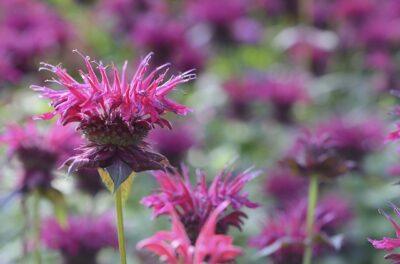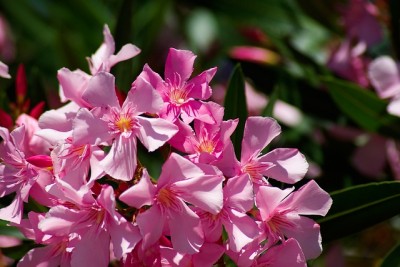
Deer are lovely, gentle animals that are a pleasant sight to see – when they are on someone else’s property, that is. As anyone who has had hungry deer visit their garden knows, deer cease to be appealing when they devour your flowers and vegetables.
Deer are crafty and agile creatures that can jump fences and find their way around many obstacles in pursuit of a tasty meal. So what are some natural ways to deter deer from your garden?
Deer tend to avoid plants with strong odors, with unusual textures — such as fuzzy leaves or spiny stems — or with bitter tastes. Therefore, you may find success in protecting your tender greens and flowers from deer by building a border around them of plants that the animals dislike.
Here are seven garden plants that repel deer:
1. Bee balm
A native wildflower that has been hybridized for gardens, bee balm can make a striking addition to your garden with dramatic summer blooms.

The fragrant flower attracts butterflies, hummingbirds and bees, but deer do not care for the aroma. You can harvest the leaves for use in salad, or you can dry them for a delicious tea.
If you have room in a sunny spot, you can let bee balm plants spread for large splashes of color. Picking the flowers or deadheading them encourages a second round of blooms. To repel deer, use it as a border plant or in containers around your garden area.
2. Chives
Deer tend to steer clear of chives because of their strong odor and flavor. Chives are easy to grow and once they are established, they self-sow. In addition, chives boast pretty white or purple flowers in summer.
To deter deer, you can plant chives throughout your landscaping and alongside your veggies. They also grow well in containers.
3. Cosmos
Available in a wide variety of color, cosmos is an easy-maintenance flowering plant that deer dislike. Cosmos tolerate a wide range of soil types and can handle dry conditions.
This New All-Natural Fertilizer Doubles Garden Production!
Cosmos plants can range from one to five feet, so they can add height and color to your beds. Pinching off flowers will increase blooming. Fast-growing cosmos can be used as a hedge around the plants deer find tasty.
4. Garlic
Home-grown garlic adds flavor and nutrition to many pasta dishes, and guess what? Deer don’t like the smell or taste of garlic. Thus, by planting some garlic bulbs among your vegetables, you can deter deer from munching on your other plants.
Other than needing well-draining soil, garlic requires little maintenance.
5. Oleander

If you’re looking for something larger to deter deer from your garden beds, consider oleander. An evergreen shrub that can grow up to 20 feet tall, oleander has attractive white, red, pink or yellow blossoms in spring and early summer.
The plant is poisonous to deer, and deer instinctively avoid it. (Note: It also is poisonous to humans, so avoid it if you have children.)
6. Rosemary
A hardy herb with needle-like leaves that are a favorite of many cooks, rosemary has a strong aroma that deer dislike.
The woody-stemmed plant can commonly reach three feet in height, and in mild climates, it makes an attractive evergreen hedge that displays white, pink, purple or blue flowers in the spring. Rosemary likes full sun and well-drained soil.
7. Russian sage
If you are looking for an attractive easy-to-grow herb that deer dislike, look no further than Russian sage. This hardy perennial will grow up to five feet tall, boasting fragrant and lovely lavender-blue flowers in the spring.
Russian sage can provide a pretty border to deter hungry deer from your veggies and plants.
Keep in mind that deer are persistent creatures, and many gardeners report that what deterred deer one season will have seemingly no effect the following season.
What plants do you use that repel deer? Share your tips in the section below:
Sources:
https://store.msuextension.org/publications/YardandGarden/MT199521AG.pdf
https://extension.oregonstate.edu/deschutes/sites/default/files/deer_resistant_plants_ec.pdf
https://www.ext.colostate.edu/ptlk/2302.html
Every Spring, Gardeners Make This Avoidable Mistake — But You Don’t Have To. Read More Here.










